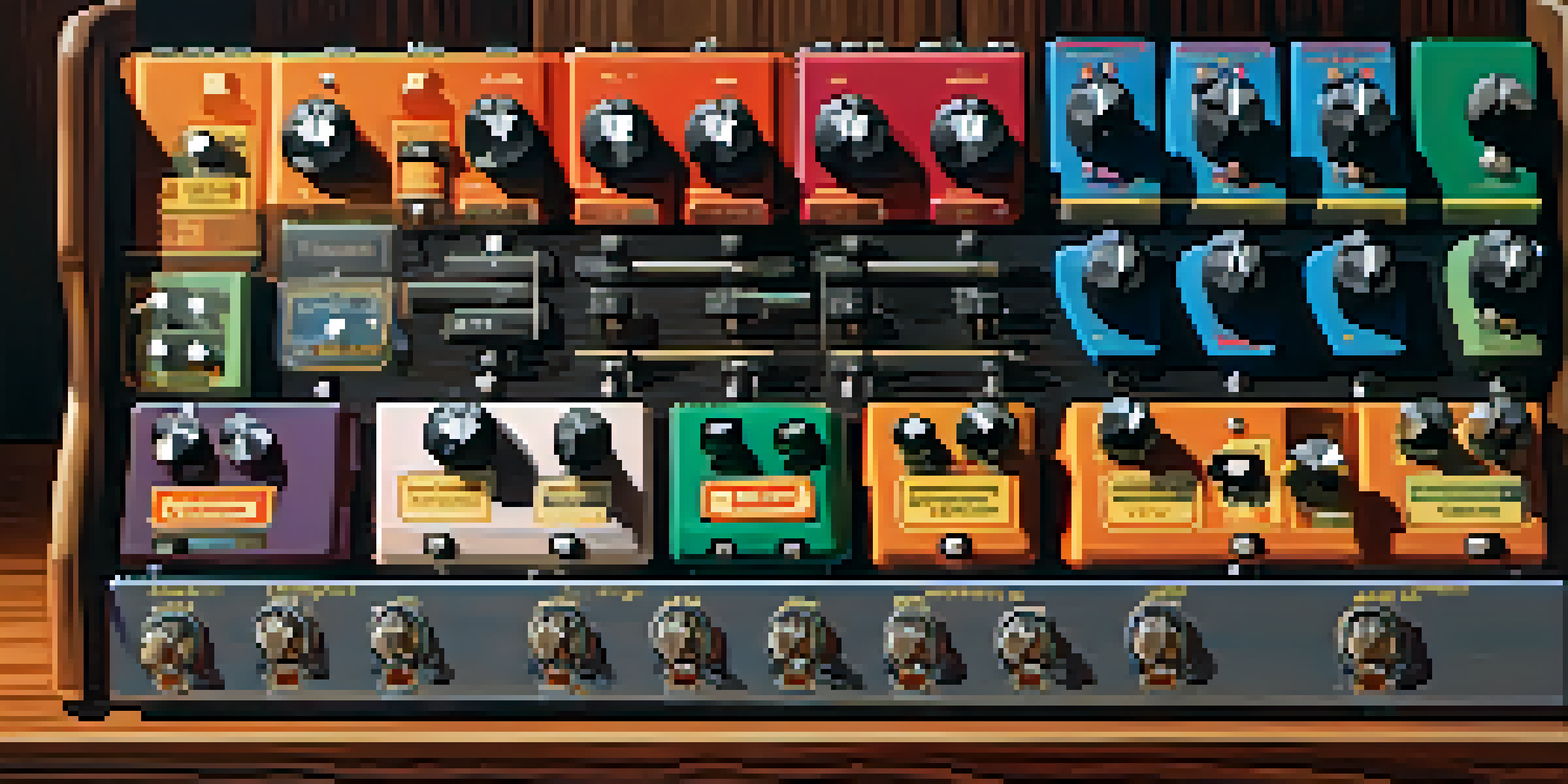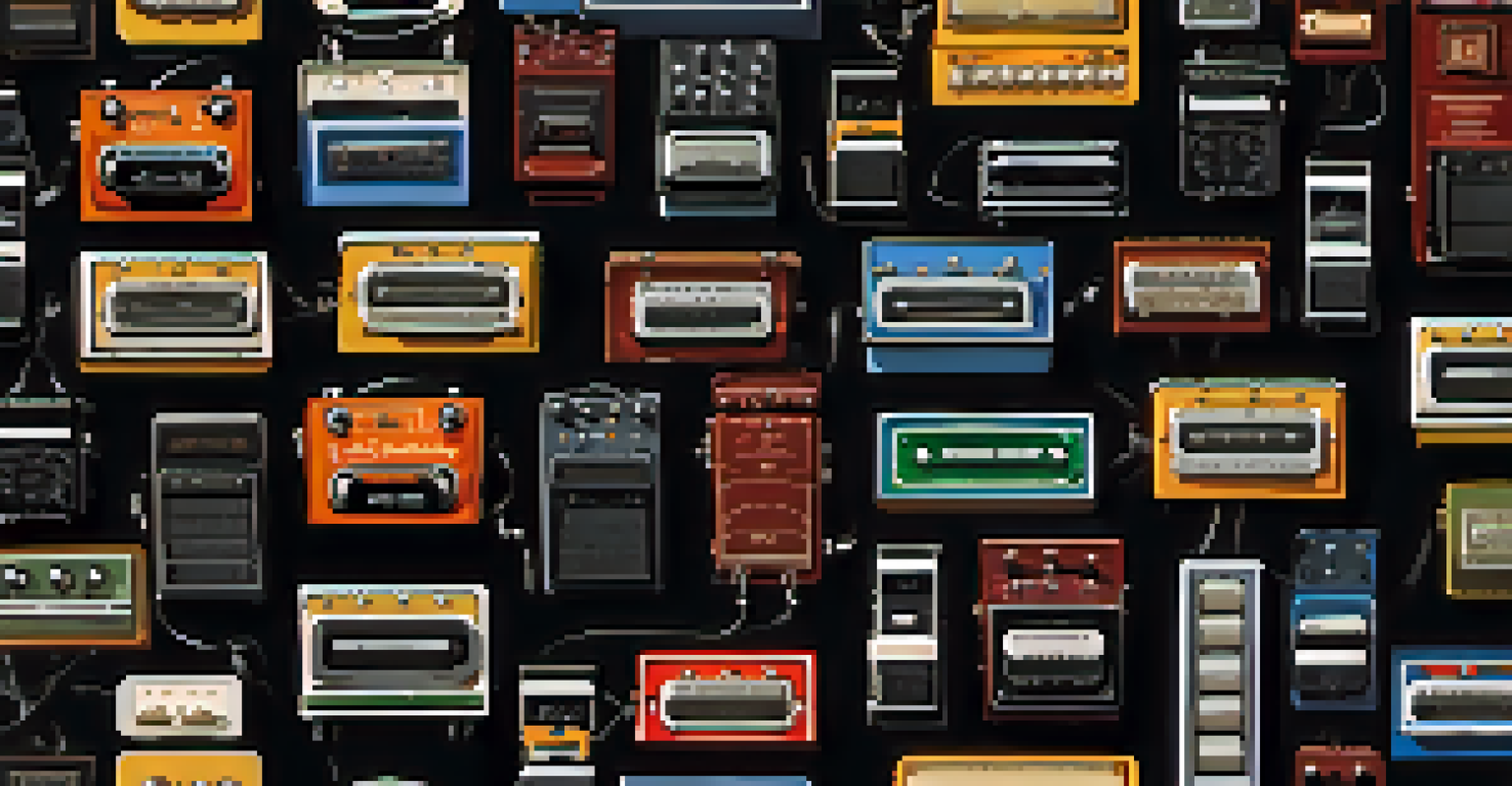Effects Pedals: Transforming the Ukulele Soundscape

Understanding the Basics of Effects Pedals
Effects pedals are devices that modify the sound of musical instruments. They come in various types, each providing unique sounds and effects that can enhance your playing. For ukulele players, these pedals can turn the simple, cheerful tones of the instrument into something much richer and diverse.
Music is the shorthand of emotion.
Think of effects pedals as spices in a kitchen; just like a dash of salt can elevate a dish, a well-placed effect can transform your ukulele sound. From reverb to delay, each pedal adds a layer of depth, allowing musicians to explore new creative avenues. Whether you're looking to add a bit of warmth or a vibrant echo, there's a pedal that can help you achieve your desired sound.
As we dive deeper into the world of effects pedals, it’s essential to understand how they can be integrated into your playing style. Using them effectively can take some experimentation, but the results can be incredibly rewarding, making your ukulele stand out in any musical setting.
Popular Effects Pedals for Ukulele Players
There are several popular effects pedals that ukulele players often gravitate towards. Some of the favorites include reverb, delay, distortion, and chorus. Each of these pedals offers a different flavor, allowing you to create a distinctive sound that complements your playing style.

For instance, a reverb pedal adds a sense of space and depth to your sound, making it feel as if you’re playing in a large hall. On the other hand, a delay pedal can create an echo effect, perfect for layering sounds or creating a rhythmic backdrop. Distortion might seem unconventional for a ukulele, but it can add a gritty edge that surprises listeners and adds excitement to your performance.
Effects Pedals Enhance Ukulele Sound
Effects pedals act like spices for your ukulele, adding unique sounds and depth to elevate your musical expression.
Chorus pedals, which create a shimmering effect by layering multiple sounds, can give your ukulele a full, lush quality. Exploring these pedals can lead to discovering your unique sound, and you might find yourself experimenting with combinations to create something entirely personal.
How to Choose the Right Pedal for Your Needs
Choosing the right effects pedal can feel overwhelming, especially with the plethora of options available. Start by considering the sound you wish to achieve; are you looking for something subtle or more dramatic? Identifying the style of music you play can also guide your decision, as certain pedals work better with specific genres.
Creativity takes courage.
It’s also beneficial to test pedals in-store if possible. Playing around with them can help you gauge how they interact with your ukulele and your personal playing style. Don't hesitate to ask for recommendations from staff or fellow musicians; their insights can often lead you to the perfect pedal.
Lastly, remember that the best pedal for you is the one that inspires your creativity. Sometimes, it’s not about having the most expensive or popular pedal, but rather one that resonates with your artistic vision and complements your sound.
Integrating Effects Pedals into Your Setup
Integrating effects pedals into your ukulele setup is a game changer. You can position them in your signal chain to determine how they interact with each other and your instrument. Typically, pedals are placed in a specific order, starting with the ones that affect dynamics, followed by modulation effects, and ending with time-based effects like delay and reverb.
A common setup might start with a tuner, then a distortion pedal, followed by a chorus, and finally a delay. This arrangement allows you to build your sound progressively, enhancing the overall output. Remember, experimenting with different orders can lead to unexpected and exciting results, so don’t be afraid to mix things up!
Choose Pedals to Fit Your Style
Selecting the right effects pedal involves understanding your desired sound and how it complements your playing style and music genre.
Make sure to invest in a good quality pedalboard to keep everything organized and easily accessible. This not only makes your setup look professional, but it also streamlines the process of switching pedals during performances, ensuring you stay focused on your music.
Exploring Creative Soundscapes with Effects
Effects pedals open the door to a world of creative soundscapes for ukulele players. You can layer sounds, create ambient backgrounds, or even simulate different environments. By using a combination of pedals, you can craft a unique audio experience that transports listeners to different realms.
Imagine combining a reverb pedal with a delay; the resulting sound can evoke feelings of vastness, reminiscent of playing on a mountain top or in a spacious cathedral. Alternatively, using a distortion pedal alongside a chorus can create an intriguing contrast between gritty and smooth tones, leading to captivating musical moments.
The key is to embrace experimentation. Don’t shy away from pushing the boundaries of what your ukulele can do. By exploring various effects, you can discover new textures and styles that enrich your music and allow your creativity to flourish.
Practical Tips for Using Effects Pedals Live
Using effects pedals in live performances can be daunting, but with some practical tips, you can navigate this with ease. First, familiarize yourself with your pedals and their settings before stepping on stage. Knowing how each pedal responds will help you feel confident when making adjustments during your performance.
Consider creating a setlist where you map out which effects you’ll use for each song. This pre-planning can reduce stress and ensure a smoother performance. It’s like having a roadmap; you know where you’re going and what to expect.
Innovations Shape Future of Pedals
Advancements in pedal technology are expanding creative possibilities for ukulele players, making it easier to explore diverse sounds.
Lastly, practice transitioning between effects seamlessly. This can be as simple as learning how to switch pedals quickly or adjusting settings mid-song. The more comfortable you are with your pedals, the more you can focus on delivering an engaging performance.
The Future of Effects Pedals for Ukulele Players
As technology advances, the future of effects pedals is looking bright for ukulele players. Innovations in digital effects and pedal design are making it easier for musicians to access a wider range of sounds and functionalities. This means more creative opportunities and a chance to explore uncharted territories in music.
For instance, many modern pedals now feature presets, allowing you to save your favorite settings for quick recall during performances. This can save time and let you focus more on your playing rather than fiddling with knobs. Furthermore, advancements in mobile apps are enabling musicians to control their effects from their smartphones, adding a new layer of convenience.

As we look ahead, it’s exciting to think about how these developments will continue to shape the sound of the ukulele. Embracing new technologies alongside traditional techniques will ensure that the ukulele remains a dynamic and evolving instrument in the music world.